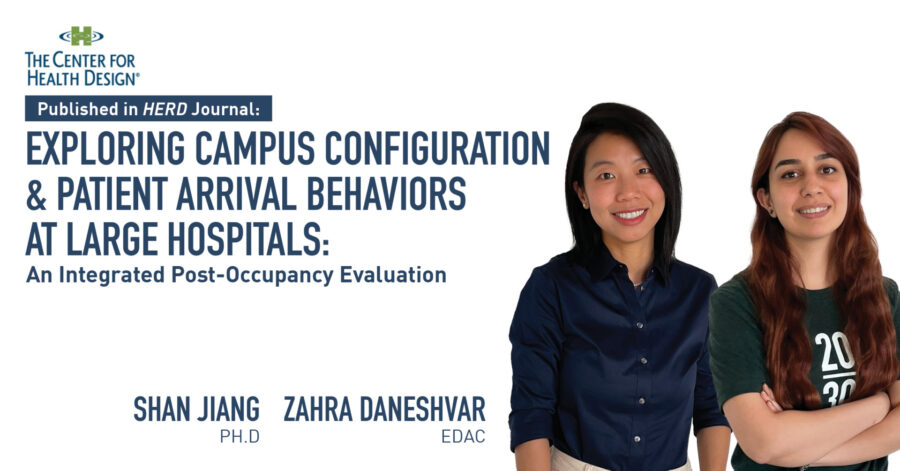Insights
Oct 23, 2024 _ insights
GBBN Research in HERD Journal: Healthcare Campus Arrival
Our latest research, which focuses on hospital arrival and wayfinding, has been published in HERD: Health Environments Research & Design Journal, a peer reviewed journal focusing on the effects of health environments on patient, provider, and organizational outcomes.
The study, titled, “Exploring Campus Configuration and Patient Arrival Behaviors at Large Hospitals: An Integrated Post-Occupancy Evaluation,” addresses the challenges in hospital navigation, particularly focusing on the sequence of arrival experiences through foot traffic or driving within a medical campus. Our post-occupancy evaluation was conducted at UC Health Medical Center after our renovations to their main arrival were complete. While previous research has emphasized wayfinding in interiors, this study recognizes the importance of transition from outdoor to indoor spaces in the hospital arrival zone. GBBN’s research team included Zahra Daneshvar, Jackson Feinknopf, Kirsten Miller, and me. Our research partners were Dr. Hui Cai of Georgia Tech (formerly of the University of Kansas) and Dr. Monalipa Dash of the Kalinga Institute of Industrial Technology.
Large-scale built environments, such as universities and hospital campuses, gain complexity as they grow and are often criticized for wayfinding and circulation difficulties. But hospital wayfinding has been closely tied to patient outcomes and overall satisfaction. For large hospitals particularly, wayfinding issues are frequently widespread and can be encountered indoors and out. Busy traffic flow and vehicle congestion near the hospital entrance can also adversely impact experience by increasing safety risks, environmental and acoustic pollution, and potential disruption to hospital operations.
This post-occupancy evaluation addressed a significant research gap in hospital wayfinding research at the campus level, particularly in the hospital arrival zone. The implications of this research on hospital campus arrival design are multi-fold:
- Patient/visitor arrival at hospitals involves several steps, transitioning from outdoor to indoor space. The design and research of patient/visitor arrival zones should consider the interconnected holistic experience.
- The connectivity and integration of spatial configurations (including the medical campus network, arrival transition space, and interior lobby) are strong predictors of the volume of patients/visitors’ movement.
- Entry points of a hospital campus should be clear and decluttered; establishing visual connections that enhance people’s ability to see the destination or next step aids navigation and progression in the hospital arrival zone.
- Strategically locating information desks at the intersections of high-traffic paths will maximize their visibility and accessibility, effectively forming socialization hubs. A buffer zone should be considered in the design around these areas to reconcile potential waiting and gatherings.
- Following human-centric design principles, direct connections should be provided between key entrances within the hospital arrival zone for disabled patients. Subwaiting areas with easy visual and physical access near the entrance could accommodate the behaviors of disabled patients and improve their experience.
See our research in the HERD Journal here.
Read more of our research here.
 Shan Jiang, Ph.D, is an associate the director of research at GBBN. An established researcher, educator, and thought leader, she has published dozens of articles in peer-reviewed journals, presented at conferences, and recently published a full monograph with Routledge on therapeutic landscapes, healthcare design, and sustainable community development. At GBBN, Shan leads firm-wide research efforts, helping design teams in all markets conduct research while drawing on the best, established research to inform their work.
Shan Jiang, Ph.D, is an associate the director of research at GBBN. An established researcher, educator, and thought leader, she has published dozens of articles in peer-reviewed journals, presented at conferences, and recently published a full monograph with Routledge on therapeutic landscapes, healthcare design, and sustainable community development. At GBBN, Shan leads firm-wide research efforts, helping design teams in all markets conduct research while drawing on the best, established research to inform their work.
 Zahra Daneshvar, EDAC is an interior designer and researcher at GBBN. Zahra combines her passions for interior design and research to create healthcare environments that uplift both patients and staff. She likes to incorporate new technologies, like video mapping, in her design process to help create immersive experiences and opportunities for positive distractions. She is a co-author of “Examining Efficacy in Open-Bay and Single-Family Room NICU Designs,” published in Advances in Neonatal Care. Her research and insights have been presented at the Kentucky Conference on Health Communication, and at the Environmental Design Research Association’s annual conference.
Zahra Daneshvar, EDAC is an interior designer and researcher at GBBN. Zahra combines her passions for interior design and research to create healthcare environments that uplift both patients and staff. She likes to incorporate new technologies, like video mapping, in her design process to help create immersive experiences and opportunities for positive distractions. She is a co-author of “Examining Efficacy in Open-Bay and Single-Family Room NICU Designs,” published in Advances in Neonatal Care. Her research and insights have been presented at the Kentucky Conference on Health Communication, and at the Environmental Design Research Association’s annual conference.




